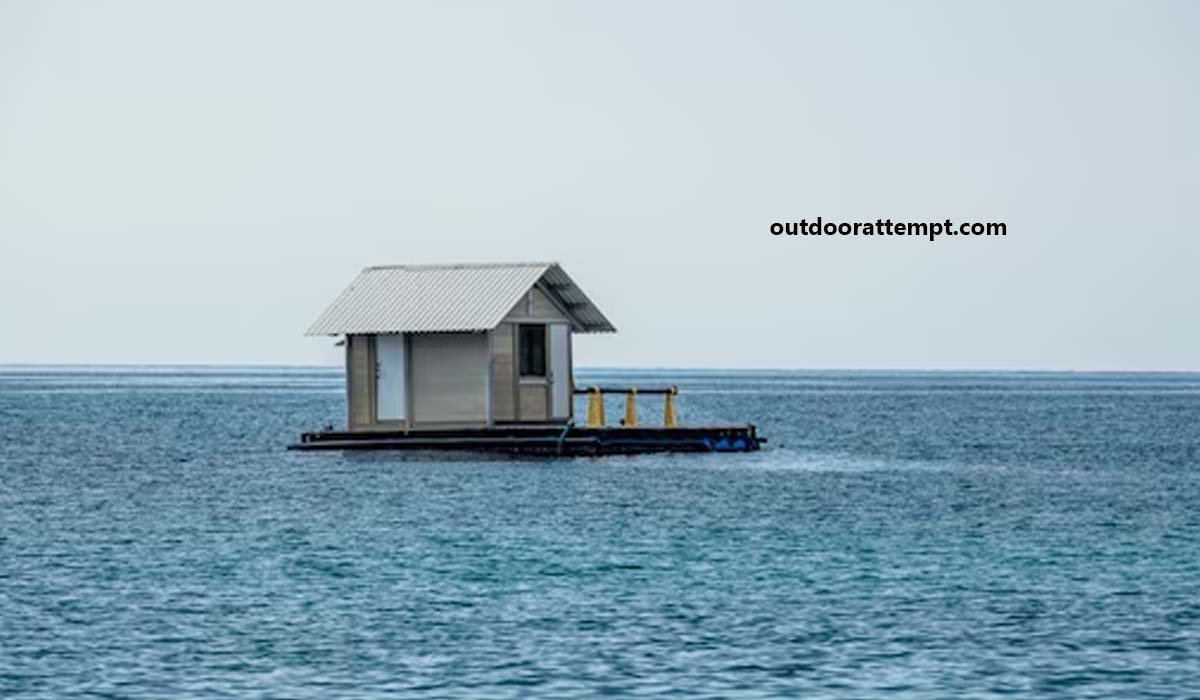Constructing Floating Homes On Water in a world marked by urbanization, population growth, and climate change, architects, engineers, and innovators are pushing the boundaries of traditional construction methods to create sustainable and adaptable housing solutions.
Constructing Floating Homes On Water
One such pioneering concept gaining traction is the construction of floating homes on water. Combining cutting-edge technology, sustainable design principles, and a desire for harmonious coexistence with nature, floating homes present an exciting vision for the future of housing.
Embracing Water as a Foundation
As the global population continues to rise and available land becomes scarcer, it’s imperative to explore alternative avenues for urban expansion.
Floating homes, which literally rest on water bodies such as lakes, rivers, and even oceans, offer a unique and resourceful approach.
These homes not only provide a new dimension to residential architecture but also challenge the conventional understanding of urban planning.
Ingenious Design and Engineering
Constructing homes on water requires a fusion of architectural ingenuity and advanced engineering techniques. One of the primary challenges is ensuring stability and buoyancy.
Engineers employ innovative materials like lightweight concrete, reinforced polymers, and composite structures to create the foundation of these homes. Floatation systems, inspired by maritime engineering, play a crucial role in maintaining equilibrium and adapting to changing water levels.
Moreover, architects design these homes to withstand the forces of nature, including waves, currents, and storms. Incorporating flexible connections, modular designs, and hydraulic systems allow these structures to adjust to water fluctuations while providing a safe and comfortable living environment.
Sustainability at the Core
Floating homes epitomize sustainable living by utilizing the water’s natural properties for heating, cooling, and energy generation. Solar panels, wind turbines, and hydroelectric systems are integrated into the design, harnessing renewable energy sources to power the homes.
Wastewater treatment systems and composting toilets further minimize the environmental impact. Additionally, the surrounding water bodies can serve as a source of food and recreational opportunities, promoting self-sufficiency and a deeper connection with nature.
Resilience and Adaptability
Climate change has led to rising sea levels and increased frequency of extreme weather events. Floating homes, designed with resilience in mind, can adapt to these changes more effectively than traditional structures.
As waters rise, these homes can be elevated or anchored to ensure continued habitation. The modular nature of floating home construction allows for easy expansion or relocation, making them well-suited for evolving environmental conditions.
Harmonizing with Nature
Floating homes offer a unique opportunity to reconnect with the natural world. Residents wake up to the soothing sounds of water, enjoy breathtaking views, and develop a heightened sense of environmental awareness.
 Many floating home communities emphasize eco-friendly lifestyles, community gardens, and water conservation initiatives, fostering a sense of unity and shared responsibility among residents.
Many floating home communities emphasize eco-friendly lifestyles, community gardens, and water conservation initiatives, fostering a sense of unity and shared responsibility among residents.
Constructing Floating Homes On Water
As urban landscapes evolve and the challenges posed by climate change become more evident, innovative solutions like floating homes provide a glimpse into the future of sustainable living.
By embracing advanced engineering, sustainable design principles, and a harmonious relationship with nature, floating homes exemplify the potential to create thriving communities that adapt and flourish in an ever-changing world.
As we look ahead, the construction of floating homes on water stands as a testament to human creativity, resilience, and the enduring connection between architecture and the environment.
Challenges and Considerations
While the concept of floating homes holds immense promise, its implementation is not without challenges and considerations.
Regulatory Frameworks:
The construction of floating homes often requires navigating complex regulatory frameworks that govern water usage, environmental impact, and zoning laws.
Collaborative efforts between architects, policymakers, and environmental experts are crucial to establish guidelines that balance innovation with ecological preservation.
Infrastructure and Utilities
Designing and implementing efficient utility systems for floating homes present a unique set of challenges.
Developing robust waste management, sewage treatment, freshwater supply, and power distribution systems that are both environmentally friendly and economically viable requires careful planning and expertise.
Community Integration
Establishing floating home communities necessitates thoughtful community planning and integration. Social cohesion, shared amenities, emergency response plans, and access to essential services must be considered to create thriving and sustainable neighborhoods.
Maintenance and Longevity
The exposure to water elements can accelerate wear and tear on materials. Requiring regular maintenance and monitoring. Engineers and architects need to collaborate closely to choose durable. Corrosion-resistant materials that ensure the longevity of floating homes.
Cost Considerations
Constructing floating homes can be more expensive than traditional land-based homes due to specialized materials, engineering, and infrastructure requirements. While the initial investment may be higher. Proponents argue that the long-term benefits in terms of energy efficiency, resilience, and ecological impact can offset these costs.
Cultural and Aesthetic Integration
Designing floating homes that blend seamlessly with their natural surroundings while respecting local cultural aesthetics is a complex endeavor. Architects must strike a balance between innovative design and cultural sensitivity to create homes that feel like an organic extension of the environment.
Future Potential
Despite the challenges, floating homes hold immense promise for addressing pressing issues of urbanization, climate change, and housing shortages.
The concept extends beyond individual residences, offering potential for floating hotels, restaurants, and even entire floating cities. Collaborative research and development efforts continue to refine the technology and design of floating homes, pushing the boundaries of what is possible.
As technology evolves, we may see the integration of advanced automation, artificial intelligence, and smart home systems into floating homes, enhancing comfort, safety, and efficiency. Floating homes could become an integral part of resilient urban planning strategies. Helping communities adapt to changing climate conditions while preserving natural habitats.
Conclusion
The construction of floating homes on water represents a bold step towards reimagining urban living in the face of environmental challenges.
Through innovative engineering, sustainable design, and a deep respect for nature. These homes showcase the potential to create resilient, adaptable, and harmonious communities.
Constructing Floating Homes On Water
As architects, engineers, and visionaries continue to collaborate on this exciting frontier. Floating homes stand as a testament to human creativity, resilience. The capacity to forge a harmonious coexistence with the natural world.
As we move forward, the evolution of floating homes will undoubtedly shape the way we perceive architecture, sustainability, and our relationship with water bodies.
